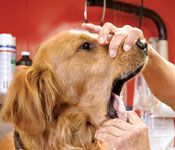Dental homecare compliance: Talk to clients about the realities, long-term costs of poor oral health
In the last 20 years, veterinary dentistry has seen tremendous growth in the education of veterinarians regarding oral health. And the message is being communicated to pet owners.
Dentistry has come a long way in the last 50 years in terms of improving human health and longevity. Even though periodontal disease was recognized in the Egyptian cultures, it was not until the post-WWII period that the United States took a leading role in periodontal research.

In the last 20 years, veterinary dentistry has seen tremendous growth in the education of veterinarians regarding oral health. And the message is being communicated to pet owners.
Many pet owners contact their veterinarians when they detect halitosis in their pets. Keep in mind that oral health has no offensive odor. The odor originates from bacteria growing in the tooth sulcus, assisting in the formation of a complex biofilm called plaque. In people, plaque can be removed through the mechanical activity of brushing and flossing (homecare).
If the plaque remains, gingival inflammation ensues, and after 48 to 72 hours, a mineralization process of the plaque begins forming calculus. Human oral healthcare accelerated in the last 50 years by the promotional activities of manufacturers of human dentifrice. In the last 20 years, many new products have come on the market for use in animals as well. Some of the products are well-documented with evidence-based research, yet other products have virtually no data to demonstrate efficacy.
In addition, providing quality dental homecare for a pet is often dictated by the owner's lifestyle, dexterity, agility and motivation in addition to the pet's training, temperament and size. Tooth brushing remains the gold standard for homecare. Unfortunately, the percentage of compliant clients is still low, and it's often reported in the single digits.
Making it easy for pet owners
Poor compliance by veterinary clients stimulated scientists and manufacturers to develop methods and products that require less human involvement. Many products have been developed that decrease plaque through the mechanical activity of chewing treats or by providing nutritionally complete diets. Others have incorporated a chemical means of chelating or binding the oral mineral materials to slow the mineralization of plaque to calculus. Wax-like sealants are used immediately after dental cleanings and are replenished at home to make the tooth slippery and, consequently, less plaque-retentive. Enzymatic pastes are used both on tooth brushes and dental chews to help free the teeth of plaque. Many chew items on the market are durable and help remove plaque, but the hardness of some of these products can fracture teeth.
Water additives offer another means of plaque control. Some of the products contain natural ingredients like grapefruit, blueberry, papaya, various vitamins, chlorophyll, yucca or cranberry extracts, while others use sugars or alcohols to reduce plaque development. Concerns have been expressed about the daily consumption of some of these chemical ingredients in water and the long-term health of the animal.
The Veterinary Oral Health Council (VOHC) was created by the American Veterinary Dental College to evaluate products through detailed clinical trials. Some products have been tested using a specific VOHC protocol to generate data that substantiate product claims. More products need to be evaluated to provide evidence of efficacy.
To date no one product provides all of the needs to produce oral health. However, a multimodal approach using as many of the methods and products as possible will provide an accumulative advantage.
The veterinarian's role
No professional is better trained to develop a lifetime preventive dental-care plan for animals than the veterinarian. As a profession, we are often guilty of waiting too long before we mention dental care to our clients. We all understand the anatomical models that demonstrate the significant changes in bone architecture that occur adjacent to teeth affected by periodontal disease.
If we are to preserve the normal "self cleaning" architecture of the teeth, gingiva and alveolar bone, we must begin early in an animal's life by including a comprehensive oral examination with the physical examination. We must recommend professional dental care when the earliest signs of plaque and calculus appear before the normal architecture is lost and periodontal pocket formation, attachment and/or bone loss develops. Once those changes occur, it is difficult to bring the patient back to normal structure and function.
If we think that dental care has been a significant contributor to longevity and quality of life in older people, it is reasonable to expect a similar response in our animal patients. Household economic conditions often dictate the level of veterinary care received by dogs and cats. It is important for veterinarians to educate clients regarding the financial burdens of chronic systemic infections and the benefits of preventive oral healthcare.
Dr. Gengler is a faculty member of the Department of Surgical Sciences at the University of Wisconsin-Madison School of Veterinary Medicine. He is president of the American Veterinary Dental College and a diplomate of the American Veterinary Dental College.